Understanding form as structure
morphology and aesthetics
by Leandro Madrazo
The notion of Gestalt as a visible idea grasped by a productive mind, which lies at the core of Goethe’s morphology, conveyed a mode of thinking and seeing form which exerted a strong influence in modern art and in design education. For Goethe, a Gestalt is an autonomous entity superseding the transcendent idea and the transient phenomenon. It conveyed the existence of a visual knowledge which could not be acquired analytically, through scientific methods, but from direct observation of nature. Later on, psychologists analyzed the inner structure of a Gestalt in order to explain the processes by which the mind participates in its visual organization. By doing so, they transformed the Gestalt in an object of scientific inquiry. About the same time, visual thinking became a subject matter in the programs of the Bauhaus and the Vkhutemas. In these schools, the education of pure form was considered the base of all artistic disciplines. The student’s innate capacity to understand form was needed to be developed in order to become professional artists, designers and architects. In this context, some of the modern art works, and some of the exercises carried out in those schools, could be taken as experiments in the psychology of form as much as artistic creations. After the advent of computers, and the subsequent attempts to transform design education through them, the pedagogy of form seemed to focus on morphological concerns at the expense of aesthetic considerations, thus breaking away from the unity of objective and subjective form postulated by Gestalt. The pedagogic programme here described aims at establishing productive relationships between the multiple dimensions of form –morphological, aesthetical, geometric– using a variety of techniques -computer technology, and traditional techniques– to understand form-making processes, without neglecting for that reason the need to develop a student’s capacity to understand form.
Pedagogic framework: the course Systems of Representation
The course Systems of Representation is the last stage of a line of work aimed at creating a comprehensive and interdisciplinary pedagogic framework to give meaning to the integration of computer media in architectural design education. This pedagogic work started in 1990 at the ETH Zurich, with a course which focused on the paradigm of “types and instances” (why the quotes?) to integrate computer modeling in the education on form (Madrazo 1999). Later, with the course Keywords (Madrazo 2000) the conceptual framework was expanded beyond the limits of computer tools, in order to create a link between computer generated form and the aesthetic principles of modern art.
A step forward in this construction of a comprehensive pedagogic framework was the course Structures, developed within the postgraduate program of the ETH during the period 1996-1999. In this course, a notion of structure was the underlying form common to a text and a figure, a three-dimensional object and a space, and a space and the light that gives form to it.
Lastly, with the course Systems of Representation, started in 1999 at the School of Architecture La Salle, we have reached one more level of generalization, moving from structure to system, considering this now as a conceptual model which enables to create an interdisciplinary framework based on the interrelationships between theory bits taken from different disciplines: form-making, graphic design, visual communication, aesthetics and computation (Madrazo 2006). The course is structured in six themes, each one standing for a system of representation: Text, Figure, Image, Object, Space and Light. Within every system, a variety of issues dealing with the concept of representation –considered in its aesthetic, epistemological and methodological sense– are addressed in an interdisciplinary manner. In the following text we will focus on the theme Object, which is dedicated to a study of the internal structure of form (e.g. three-dimensional objects) in the tradition of the pedagogy of form born out of the confluence of morphology and aesthetics.
Morphology: understanding form, a form of understanding
In ‘Bildung und Umbildung organischer Naturen’, Goethe defined the principles of a new field of study, “the study of the gestalt, the formation and the reformation of organic objects” (die Lehre von der Gestalt, der Bildung und Umbildung der organischen Körper), to which he gave the name ‘Morphologie’, the study of form. The idea that a form in nature is more than the sum of its constituent parts was a basic tenet of the new discipline. The goal of morphology would be presenting (darstellen) –rather than explaining (erklären)– the intrinsic relationships between a whole and its constituent parts, making these relations intelligible.
The notion of Gestalt lies at the core of to (choose one) the new discipline. A Gestalt conveys for Goethe the complex of existence of an actual being, an abstraction which is taken as congruous whole to be determined, completed, and fixed in its character. This concept of Gestalt acts as the nexus between being and becoming, between permanence and change. In the course of his writings, Goethe used also other terms to give expression to the idea of form as immanent principle, like archetypical plant (Urpflanze), archetype (Archetypus), and, in his later writings, type (Typus). For Goethe, a type is not a static, geometric scheme used to classify natural beings – as it is for Cuvier; it is not permanent but dynamic and, therefore, it can only be apprehended in its becoming; it is an immanent principle, a law which can only be apprehended through the mind’s eye (Cassirer 1950).
In Goethe’s view, nature was an artist with the capacity to unfold the potential of an immanent law, carrying out systematically a construction plan or body plan (Bauplan) giving rise to endless variations of plants and animals which revealed through their diverse appearances a unique underlying principle, the type. Incidentally, this was the very same capacity that a sensitive beholder exerted in order to grasp the unity within the variety of forms created by nature. Natural philosophy and aesthetics become at this point undistinguishable: understanding the power of nature became an aesthetic experience.
In fact, the issues raised by of (choose one) Goethe’s morphology transcend the realm of natural philosophy, having metaphysical and epistemological implications as well. For Goethe – as incidentally for Aristotle – the idea, e.g. Gestalt, morphe, is immanent to a being. It does not lie in the transcendental realm where Plato had placed it, nor is the idea embodied in subjective conceptual structures, as Kant had suggested. Rather, the form – Gestalt, Typus – lie in the phenomenon. In order to grasp it, the idea needs to move towards the experience, and the experience towards the idea (Cassirer 1950). It follows, therefore, that knowledge cannot be separated from experience: perceiving a form is a dynamic process of understanding in which both object and subject participate, under the particular circumstances set by the phenomenon.
This process of understanding does not involve the analytical capacities of the mind as in Kant’s ‘Verstand’ (e.g. understanding by means of concepts). Rather, it requires a capacity o (of?) synthesize the particular in the general, to perceive the reciprocal relationships between the whole and the parts as a totality, in an intuitive manner. Goethe’s morphology was an alternative to the scientific study of nature, which divides this into elements suited to the methods of particular disciplines, thus destroying the inherent unity of living beings. For Goethe, understanding form –grasping the indivisible idea– conveyed a reconciliation of sensation and thinking, intuition and reason. His morphology was a form of knowledge that superseded the division between science and art, between subject and object.
Gestalpsychology: explaining the mechanisms of form perception
One of the strands of thought stemming from Goethe’s notion of form led to gestalt psychology (Gestaltpsychologie). As Köhler explained it: “In the German language –at least since the time of Goethe, and especially in his own papers on natural science– the noun 'gestalt' has two meanings: besides the connotation of ‘shape’ or ‘form’ as a property of things, it has the meaning of a concrete individual and characteristic entity, existing as something detached and having a shape or form as one of its attributes. Following this tradition, in gestalt theory the word 'gestalt' means any segregated whole.” It can be argued, however, that for Goethe a Gestalt was not something detached from a being, but intrinsically united to it, such as inherent law or principle regulating its development through time. It is certain though that this autonomous entity –a Gestalt– became the object of study of the new field.
Unlike Goethe, psychologists were interested to (in) explain (-ing) the processes by which the mind participates in the construction of a Gestalt. As these scientists of the mind contended that “what happens to a part of the whole, is determined by intrinsic laws inherent in this whole” they were not referring to the object itself (or to the living being) but to the intrinsic qualities of a perceptual construct (Wertheimer, 1925, p. 7). Gestalt itself became the object of study. Most important among these laws, was the law of Prägnanz, which was defined by Wertheimer in these terms: psychological organization will always be as ‘good’ as the prevailing conditions allow (Koffka 1935, p. 110). A Gestalt is both an organization and the result of the process of organization or, in other words, it is the manifestation of a moment of equilibrium between the inner structure of the shape and the structuring power of the mind.
Gestalt psychology aimed to demonstrate empirically the existence of organizational principles that come into play in environmental perception. Matching abstract shapes with visual stimuli was not a distinctive capacity of a talented artist but an innate capacity of the mind.
Form and modern art: interweaving of morphology, psychology and aesthetics
Some of the qualities that psychologists thought to be characteristic of a Gestalt, like simplicity, regularity, symmetry, and stability, had aesthetic significance: a ‘good’ gestalt was necessarily ‘beautiful’, since it was a manifestation of a harmonic relation between object and beholder, a relation of empathy comparable to an aesthetic experience. As abstract form became the language of modern art, the boundaries between artistic creation and Gestalt experimentation blurred. Both seemed to share a similar objective: understanding the structure of form.
It was necessary to wait to the advent of modern art so that the notion of form as inner law or principle which emerged during the eighteenth and nineteenth century in the scientific study of nature –Haüy’s mineralogy, Cuvier’s biology– and in natural philosophy –Goethe’s morphology–, disclosed its aesthetic potential. Before this happened, it was necessary that the notion of form as structure would not be constrained to the object –nor to the mind– and reached out the realm of perception and visuality. Once it became established that the structure of form is inextricably knitted with the form of seeing, art could be reformulated as a product of the mind’s capacity to create form.
In parallel to the abstract works produced by modern art –in painting, sculpture and architecture–, it emerged an awareness about the mechanisms of form perception which is manifested in the aesthetic theories of Fiedler, Vischer, Lipps, Schmarsow, Wölfflin, and Hildebrand, among others. Understanding the mechanisms of perception was a concern not only for art theorists, but for modern artists as well. Malevich, Kandinsky, Klee and Mondrian were not only painting, but also reflecting on the meaning of the ground-breaking works they were creating. For these visual thinkers, a painting was an opportunity to explore some transcendental issues regarding the nature of form and form perception.
In the reflections of modern artists the morphological, psychological and aesthetic approaches to form became intermingled. Kandinsky, particularly, was not only concerned with the inherent properties of the point and the line, considered as pure geometric or graphic elements. These basic elements were the material which both the artist and nature used in their creations: “the line is present in numerous forms in Nature: in the mineral, plant and animal worlds” (Kandinsky 1955, p. 117, author’s translation). At the same time, he was concerned with the understanding of the visual structure of a form and, with that purpose, experimented with form perception in much the same way as a Gestalt psychology could do. As he tried to explain the relation between the lines that make up a composition and the overall figure, he came to the conclusion that “ it is not easy to delimit what is complicated and solely to make use of what is elementary. Nonetheless, these experiments and observations offer the only means to enter the realm of the nature of painting” (ibid., p. ?, author’s translation). Finally, there are some aesthetic implications in Kandinsky’s theories concerning the notion of empathy (Einfühlung) – that is, the projection of our sensations onto an object to endow it with life: “Thus the composition is nothing else than an exact law-bound organization in the form of tensions of the forces within the elements.” (ibid., p. ?, author’s translation),
At this point, as the morphological, psychological and aesthetic notions of form became interwoven, an idea of form started to emerge which could be shared both by science and art: the notion of form as structure.
Form as visual structure
In the reflections of artists and art theorists in the turn of the twentieth century, the notion of form as an underlying structure which arises from the interaction between the work of art and the beholder pervades. The work of art no longer reproduces an external reality; it is reality. Its reality is the intangible structure which is revealed in the aesthetic experience.
The idea that an art form is fundamentally a visual structure which is manifested to the beholder is presented in the book of Adolf von Hildebrand, Das Problem der Form in der bildenden Kunst, (English title: The Problem of Form in Painting and Sculpture) first published in 1893. According to Hildebrand, the problems of form to which the artist is confronted are given by nature, and dictated by perception. Underlying any imitative form, there is an underlying abstract structure which holds the different appearances together as an architectural construction. The goal of the artist, painter or sculptor, is to create images which provide the minimum necessary information to activate the beholder’s capacity to conceive form (Formvorstellung). He distinguishes between form and effect (Wirkung), between the intrinsic formal qualities of the object, its real form (Daseinsform) and its various appearances (Erscheinungsform) influenced by light conditions and view points. While a real form is independent from change, an appearance is an active form, constantly changing as the beholder strives to find an equilibrium between its visual constituents.
By considering that the essence of an art form lies in its underlying visual structure, aesthetics became closer to Gestalt psychology (Gestaltpsychologie), moving from the appreciation of beauty to the understanding of form. This confluence of aesthetics and psychology pervaded the later work that Rudolf Arnheim Art and Visual Perception. The findings of Gestalt psychologists provided him with the instruments to analyze art forms visually, rather than linguistically. A fundamental tenet of his visual analysis is a distinction between visible shape and structural skeleton, that is to say, between the tangible lines and masses produced by the artist, and the structure created in perception by these material shapes; a distinction which, incidentally, cannot but evoke the notions of real and active form formulated earlier by Hildebrand.
Form-based education: Bauhaus and Vkhutemas
The alternative models of education postulated by reformists like Froebel, Pestalozzi, Rousseau, Montessori and others, constitutes another line of thought which converged with the morphological and psychological studies of form at the teaching in the Bauhaus. In particular, Froebel’s Kindergarten system contributed to forge a link between morphology and the field of education, thus paving the way to the later courses of Itten and Albers. The three kinds of froebelian gifts –forms of nature (or life), forms of knowledge (or science) and forms of beauty (or art) – are consistent with Goethe’s view of the world as indivisible unity which should not be fragmented by artificial knowledge systems, but grasped as a totality.
The objectives of the preliminary courses at the Bauhaus were “to liberate the student’s creative power, to give him and (an) understanding of nature’s materials, and to acquaint him with the basic principles which underlie all creative activity in visual arts” (Bayer et al. 1975). Working with elementary forms (circle, triangle, square, cube), students acquired knowledge by direct experience, rather than by applying theories. This inductive method of instruction, as Albers named it, enabled students to gain knowledge of some universal formal principles like harmony, rhythm, scale, proportion, and symmetry, in much as the same way Froebel’s pupils discovered those principles composing forms with a set of elementary blocks.
Along with the Bauhaus, the educational program carried out at the Vkhutemas in the early 1920s is also a necessary reference in form-based design education. In that time, teachers like Korolev and Lavinski put together a discipline called ‘Volume’, dedicated to study compositional principles with elemental solids (interpenetration of masses, relation between volume and space). The pedagogic programme of the school developed from the crossing interactions between the different art disciplines and the natural science disciplines of the time, like psychology, physiology, psychophysics and psychotechnics. Ladovski, in particular, was interested in investigating perception empirically, developing his own techniques for that purpose. Golossov, on the other hand, was concerned with the intrinsic properties of forms and the meaning associated to them. He differentiated between objective and subjective mass: the first is independent of other masses; the second one is the result of the harmonic relationship between masses. Also, he distinguished between form with content and form without content, which he called mass.
Computers in form education: representing structure and process
Since the advent of the first computer graphics applications in the early 1960s, designers, design theorists and design educators have been confronted with the challenge of using computer graphics programs as design tools: as design generators, and/or as drawing and modelling tools (Reichardt 1971). In the field of architecture, the computer has been seen as an opportunity to establish a scientific base for the discipline (Mitchell 1990), or to expand it onto new territories (Novak 1988). In spite of the attainments that might have been achieved, the issues explored and debated over the last forty years with regard to the role of computers in architectural design are still far from being settled. As the initial expectations of replacing traditional design methods by computer-based tools have not been fulfilled, computer tools have ended up coexisting with the techniques they once were expected to replace. In the meantime, as the world of design has become more and more intangible (both with regard to the objects and the processes of design), the clear-cut division between digital and physical world has blurred. Nowadays, we are witnessing a progressive process of hybridization which is dissolving the boundaries between real and virtual, material and digital, geometric and natural, subjective and objective, process and product (Zellner 1999).
With a CAD program, a three-dimensional object is created upon the two-dimensional surface of the display. Unlike physical modelling, in digital modelling the three-dimensionality is not intrinsic to the materials used to create an object. In computer modelling (rapid prototyping techniques notwithstanding), three-dimensionality –of the forms and the space they lie in– exist on the mind of the designer and in the mathematical descriptions of the shapes which are computed and visualized, according to the system of representation furnished by analytical geometry. If we would apply Hildebrand’s characterization of form to computer modelling, we could contend that the real form is the geometric description of an object which is stored in the database; the apparent form are (is) its multiple visualizations projected on the display, and the effective form is the conceptual structure that the designer has in mind as he or she builds the forms on the computer. These three forms are interwoven in the process of creating a digital model. Indeed, from the three the active form (e.g. the emergent shape, the Gestalt at a given moment) is the most decisive in the design process, and this is precisely the most difficult for the computer to capture. It is the form that serves as nexus between computer and mental representations; a form that lies between both planes of representation, at the mind and at the computer, not residing actually in any of both.
Inevitably, a designer working with a computer modeller becomes aware of the inner structure of the object he or she is creating: the elements the object is composed of, the rules for assembling the parts. The same could be argued though with regard to physical modelling: as we construct a model with wood pieces or metal sheets we are aware of the parts and their assembly. Moreover, with a physical model we gain a tactile dimension that the computer takes away from the design (material, texture, size of the object with regard to the body). Perhaps the fundamental distinction between the two modelling techniques –digital, physical– is that what is being represented in the computer is not so much the object itself as its generation process.
System of Representation: OBJECT
The theme Object in the course Systems of Representation deals with the notion of form as structure, embracing both the morphological and aesthetic dimensions of form: a notion of form which was at the core of the concept of modern art and still is a necessary reference for the contemporary pedagogy of form.
In line with the tradition of form theory (Gestaltungslehre), we are considering that there are some basic principles underlying form regardless their source (art, nature), artistic expression (architecture, sculpture), material and production techniques (handmade, digital). However, developing a student’s competence to understand form conveys not only grasping some principles amenable to description and systematization, but also to cultivate a faculty –which we assume is inborn, but which must be exercised and developed– to see forms, that is to say, to creatively perceive the dynamic interaction of the elements participating in the configuration of a visual structure. We believe it is still necessary for architecture students to study form in isolation from its specific architectural qualities (tectonics, function), in order to develop a capacity for abstraction and visual perception which then will be helpful when it comes to design a building. The course has, therefore, a propaedeutic character: its purpose is to develop the capacities of architecture students to conceive and perceive forms, with independence of their architectural significance. Through the construction of three-dimensional abstract objects what we are actually building are the conceptual structures to understand form.
We are purposefully using the term Object to name this course to supersede an ever lasting division not only between art forms (sculpture, architecture) but also between these and natural forms. In the tradition of Goethe’s morphology, form can be understood as the inner structure or gestalt controlling the process of development of a natural being, as captured by the mind. Accordingly, we dedicate some lectures to explain the structure of minerals and the growth of plants, the relation between the shape of an animal and its motion, and the influence of the environment in the forms of living creatures. These notions of morphology and morphogenesis are not only valid to the study of forms in nature, but are also relevant to every form creation process. What we expect students to grasp and transposed later to the individual and collaborative exercises is the idea of process, the development of a form over time. Then the key issue becomes the transferring of some notions of growth and development from one to another realm, from morphology to design, keeping both realms apart, but nevertheless related.
Both kinds of forms, natural and artificial, can be aesthetically appreciated, but only art forms are the outcome of an artistic will. As Lavrentiev has contended with regard to the spatial constructions of Rodchenko, “it is true, that structures exist in nature, but they are simply the products of the actions of general laws. However, it is already an artistic statement when a person decides to reveal to others this structure as an artistic fact, as the result of his invention or his vision” (Lavrentiev 2002). A failure to distinguish between both realms might result in the creation of forms which look too much like natural forms, to the point that it becomes no longer possible to distinguish between the representation of a natural phenomena and an art form.
When it comes to form creation we have to take into account not only the morphological aspects –explanation of the causes that make a form grow– but also the ‘aesthetic’ significance of form –form, as form in the mind. If we would be only interested (we where only interested) in understanding the generation processes of form, it would be enough to stay within the realm of morphology –the scientific study of form which followed after Goethe’s idealistic morphology. And if we would be concerned with the subjective aspect of form creation, we would be teaching design –drawing and modeling–. Indeed, we aimed to do both, simultaneously: learning to see form, and learning to understand its inherent properties.
Concerning the use of computer tools, in our course we are promoting a creative exchange between digital and analogue techniques in the process of form generation. The fact is, that after more than three-decades after (( - after) more than three decades after) computers started to be used in architectural design, they have not done away with (they have not gotten away with) the so-called manual, traditional or analogue techniques (Bermudez and King 1998). At some point, it became clear that rather than trying to replace sketches and physical models with CAD drawings and models, it would be more appropriate to integrate both techniques in the design process, combining the intuitive representations done with traditional techniques and the systematic representations made possible by computers (Madrazo 1990). This way, the role of computer tools in design might be found within a network of crossing relationships between different media. Accordingly, a design would be the result of the interactions from one media to another, the outcome of a process of translation and re-translation, partly controlled by the designer and partly determined by the intrinsic characteristic of each medium in interaction with others (Herbert 1994).
Formal languages: Line, plane and solid
Following the work initiated by modern artists to explore the visual and morphological structure of form, we have divided the theme Object in three parts, each one dedicated to one formal language: line, plane and solid.
(Figures: linear constructions from Rodchenko, Klutsis; plane constructions from van Doesburg, Vantongerloo; solid objects from Malevich, Vantongerloo)
We consider line, plane and solid as constituent visual elements of a structure which can be materialized with a variety of techniques (digital modeling, physical modeling). These elements organize themselves according to some laws inherent to their morphological/spatial properties: a line connecting points in space, the partition of space by a surface, and the void embedded in the mass. Furthermore, when we refer to ‘language’ we are not thinking of things produced by a set of rules, as it has been understood by in the shape grammar formalism, but rather as expression or style characterized by the predominance of a particular geometric element (line, plane, solid) in the active form.
We expect students to understand the specificity of each formal language, not only as composition of elements, but as a structure in space. There is an idea of space which is inherent to each language –line, plane and solid. Within a linear structure – for example, the spatial constructions of Klutsis and Stenberg–, space can be seen as volumes enclosed by edges, or as preexisting abstract void that the connecting points made visible. The movement of a line in this abstract, infinite space has no end, no limits. In an assembly of planes, each plane divides space in opposing subspaces: left and right, above and below as in the counter-constructions from Van Doesburg, for example. Under the ruling of the language of the plane, lines are not active elements –as in the formal language of the line– but are subsumed under the surface. Planes can be folded and cut, translated up and down, left and right, thus subdividing the spaces they delimit accordingly. Within a structure of planes, space becomes an energy flowing through the interstices left between them, moving at different speeds, as it becomes first compressed and then liberated from the pressure exerted by planes, as it occurs in the Berlin chair from Rietveld. Finally, in a composition of solids, the volumes carry space within them: the limits of space coincide with the limits of the form, as in a composition of solids from Vantongerloo. This self-contained space becomes visible as we subtract mass from a solid. Subtraction, union and intersection are the basic operations to perform with solids. Under the rule of the language of the solid, lines and surfaces detract from the presence of the mass and the void.
Fig. XX. Spatial construction, Klutsis
Fig. XX. Counter-constructions, Van Doesburg
Fig. XX. Composition of solids, Vantongerloo
In this notion of formal language we are postulating, line, plane and solid are not absolute geometric entities, but constituent elements of a visual structure integrated in an overall structure and as such, having a relative value. A line or a solid is a temporary condition which can change depending on the relationship between the element and the totality of which is part of. Bearing in mind Hildebrand’s distinction between Daseinsform and Wirkungsform (wirkungsform = effective form ?), we would think of a composition of solids from Vantongerloo, for example, as being made up of solids only if we consider it from the point of view of its material construction, as a real object. However, under certain conditions of light and position of the spectator, the same composition could be thought of being constituted of lines and planes, rather than solids. In this case, the visual structure which emerges in the mind of the beholder would the –active form– would not coincide with the real form.
Implementation of the course
The theme Object is carried out during twelve weeks in the third year of a five year academic program. Teaching activities consist of two-hour lectures, plus four hours dedicated to exercises and tutoring of work made outside class hours. The task for each to create abstract three-dimensional objects for each one of the three formal languages: a construction of an object resulting from the motion of a line in space; a generative process leading to a configuration of planes in space; and designing the step-by-step process of transformation of a solid object.
These objects are devoid of architectural significance (e.g. scale, function, context, tectonics). All of the objects produced in these exercises are architectonic constructions, only in the sense that Hildebrand gave to the term architecture: a structure which can be visually recognized as totality. There is a deliberate intention to stay away from architectural issues, and concentrate in (on?) the inner logic of form. We encourage students to achieve the utmost simplicity in their designs, striving to achieve complex forms with minimum formal resources and avoiding the misuse of computer tool to generate simply complicated shapes, as opposed to meaningful forms.
Exercises are carried out using a variety of techniques, manual and digital, working individually and in collaboration. The exercise on the language of the line is done using a computer-modeling tool specifically created for this course called I-Line. With this tool it is possible to model a complex linear structure simply dragging the cursor on the screen, without having to set construction planes or having to use modeling tools. To create objects based on the language of the plane, we use commercial software to make animations of the generation process. The exercise on the language of the solid is done collaboratively, using a web-based learning environment created also specifically for this course. In this environment, students develop three-dimensional forms in a step-by-step fashion. In every exercise, physical models are made either during the development of the work or after the digital model of the object have (has?) been completed.
Object: Line
The works of Russian constructivists are the starting point for the theoretical discussions on the language of the line. Rodchenko pulled the line out of the canvas and used it as generator of objects in three-dimensional space. In a text dedicated to the line, published in 1921, he wrote: “Line is the first and the last thing; in painting as any other imaginable form of construction” (Rodchenko 1991). With his spatial constructions Rodchenko explored in a systematic manner the formal language of the line –as well as the plane and the solid–. The series of simple objects he created can be understood in two ways: as derivations of a set rules of composition applied to a vocabulary of elements, or as forms embedding design principles which can be used to generate new objects. It is the explicit and implicit design knowledge conveyed by these objects what (that?) makes them pedagogically significant, still in our days.
Besides Rodchenko, other Constructivist artists were committed to investigate the language of the line with their non-utilitarian constructions: the diagrammatic forms of Ioganson; the telescopic structures of Klutsis, which recalled the ones previously created by Rodchenko; the structures of Stenberg, which integrate object and podium in a unique construction; and the revolving spirals supporting the skeleton in Tatlin’s Monument to the Third International. These early investigations on the formal language of the line were continued further in the tensegrity structures of Kenneth Snelson, in the delicate spatial diagrams of Gego, in the framed structures by Sol Lewitt and the three-dimensional grids of François Morellet, as well in the works of contemporary artists like Waldemar Nottbohm, whose sculptures are the materialization of a path in space.
Following the discussion of these works in the lectures, students carry out a series of exercises working with digital and physical models, individually and in collaboration. It is the task of the student then to formulate an exercise which follows from the topics explained in class.
Exercises: Line
The individual exercise consists of creating a three-dimensional structure using I-Line (intuitive line), a computer application specifically created by our research group to carry out the exercise (Figure XX). With this tool, students can model complex three-dimensional structures in an intuitive manner. Lines are generated by dragging a cubic cell on the screen. The modelling procedure allows the user to do without the characteristic modelling aids of CAD programs (setting construction planes and coordinate systems). The tool is able to detect the direction of the movement of the cursor and extend the line in any of the six directions of Cartesian space. Once a structure is modelled, it is possible to select portions of it to duplicate them, so that they become seeds for the creation of new objects.
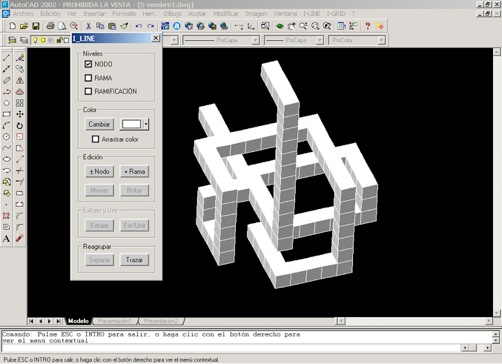
Figure XX. Interface of the tool I-Line
Besides the ease to generate three-dimensional linear objects, I-Line facilitates the understanding of the internal structure of the form. Lines can be generated out of existing lines, in a recursive manner, in much the same way as the branches of a tree stem out of other branches. Then, lines can be selected either as single segments or as branches consisting of a group of segments. Branches can be easily translated, and rotated, at the click of a button. The ultimate goal of the tool is to facilitate the dialogue between computer tool and designer, removing all unnecessary operations from the modelling process, so that creating a form becomes the result of a fluid dialogue between designer and computer (Madrazo 1999).
Furthermore, I-Line enables the designer to recognize different active forms in the object as this is being created. An existing configuration of lines can be retraced to create new objects, having a different structure. This way, the design process can proceed by further transforming the re-structured object, in ways that were not possible on the original one.
In the exercises done with I-Line, students are confronted with the task to create a three-dimensional object based on the language of the line. This means not only to build an object with lines –something that is already brought about by the tool– but, moreover, that the active form is perceived as a linear structure. Different design strategies can be identified in the works done by students: connecting points with line segments; constructing three-dimensional lattices repeating a module; thinking of a line as a path which advances, recedes and turns; characterizing lines by color, thickness or texture. Thinking of a form as being generated out of a seed raises the question of the limits of the object’s growth. The line could be endlessly moving, expanding through space without an end. At this point, the student should be aware of the moment when a structure has reached a point of equilibrium –a balance between density of the form and the occupied space, for instance– that prevents it from growing beyond its own limits.
The individual exercises are submitted to the web-based learning environment NETWORKING: OBJECT, created expressly for this course (Figure XX). Students submit a series of views of the object they have created. The views can stand for the object’s construction process, or simply show an object from different points. In any case, publishing the work in the web space makes students aware of the importance of the visual qualities of their work: selecting the appropriate perspective viewpoints and using the rendering techniques that keep the abstract qualities of the object is fundamental to depict it in a way that can be easily understood by others. Once the objects have been submitted, students can attach concepts to the objects of their peers, and make groups of objects having some common features.
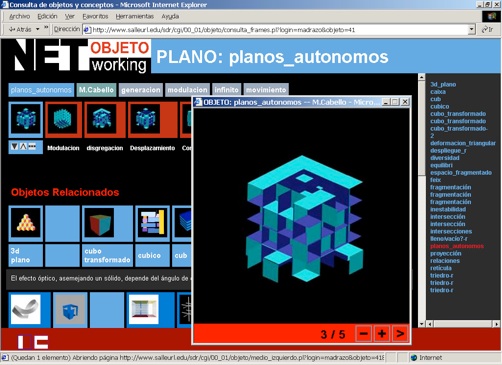
Figure XX. Interface of NETWORKING:OBJECT
The subsequent physical translation of objects created with the digital tool raises other kind (kinds) of issues. We explicitly ask students not to make a physical replica of what they did on the computer. Rather, we expect that they grasp the idea of an object – and its generative process– in order to translate it to another media.

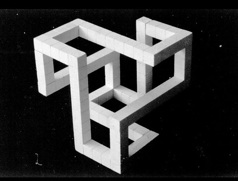
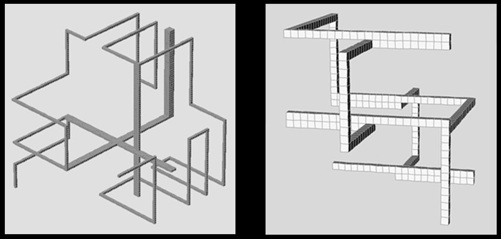
Figures XX. Student’s exercises on the language of the line
Object: Plane
Constructivist artists also explored systematically the formal language of the plane, and its relation to space. The pictorial constructions of Popova help to understand the relationship between plane and space. Tatlin’s ‘Selection of Materials’ consists of planes that stand out from the canvas onto physical space. A non-objective sculpture from Rodchenko is the result or (of) cutting, folding, intersecting planes in space. The torso and the faces from Gabo are assemblies of planes in space. A different line of research on the formal language of the plane was carried by De Stijl. In particular, the projects from by (one or the other) Van Doesburg and Van Eesteren for the Rosenberg house, which gave rise to Van Doesburg’s counter constructions, exemplify the interactions between painting, sculpture and architecture, to convey a conception of space-time.
After the period of the artistic avant-gardes, other artists continued exploring the relation between plane and space. In this regard, the work from the Basque sculptor Jorge Oteiza in the 1950s is particularly relevant. Oteiza committed himself to the task to take sculpture to the limit, to reach its ultimate level of abstraction: the void, that is, nothingness (Oteiza 1957). In the case of sculpture this means to do away not only with any trait of figuration, but with form itself. Form was considered by Oteiza an obstacle that prevented sculpture from arriving to its absolute true: space. His metaphysical boxes (cajas metafísicas) represent the ultimate level of abstraction that sculpture could achieve: planes prefiguring a space without form, a void. In these works, the void won over the mass, the material, and the form. The mass was no longer the material the sculptor worked with, but the void. Also the endless bands from Max Bill, the assemblies of Anthony Caro, among others, are discussed as different manifestations of the formal language of the plane.
Exercise: Plane
The purpose of the exercise is to create a configuration of planes, showing the process of space occupation through an animation. Used in this context, commercial animation software becomes a tool to design a generative procedure. We use animation with two purposes: to represent the process of growth of an object; and to make the potential motion inherent to a static object explicit. In the first case, the student’s task is to come up with a process of growth that shows the evolution from a simple configuration of planes to a more complex structure. In the second case, the animation is made after the object has been created to show all the alternative configurations the object can adopt, without losing its structural characteristics. In this second case, a correspondence should be observed between the form of the object and the form of the motion.
The exercise is carried out simultaneously with digital tools and with physical models. Different strategies have been adopted to integrate both techniques in the form making process. In some courses, we have asked students to translate a digital model into a physical model placed inside a transparent cubic box of 25 cm. side. Material and technique, size and scale, weight and gravity might be overlooked in the digital model but they cannot be neglected in the construction of a physical model. Again, what we expect students to do is not just a physical replica of a digital model (as in rapid prototyping) but to translate the essential characteristics of an object from one media to another.
In a recent course, during the academic year 2006-07, we have used a different strategy. At the beginning of the exercise we handed out a cardboard box, like those used for storage and moving. The task was to transform the box into a spatial configuration of planes which set limits to space. In other words, they should give form to space, by limiting the flow of spatial energy through the object. The formal exploration was done simultaneously with the box and with the animation program. At the end of the exercise, students handed out one physical model which would correspond to one animation frame; precisely the frame representing that moment in the development process in which the qualities of the object (equilibrium between plane and space; expression of motion potential) are best synthesized. With this strategy we have been able to intertwine physical and digital tools in the form generation process, superseding the distinction between conception and presentation stages.
As with the exercise on the line, individual works are submitted to the web-based environment, so that concepts are attached and groups are created.
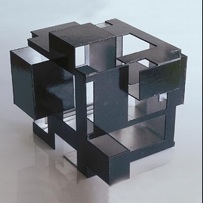
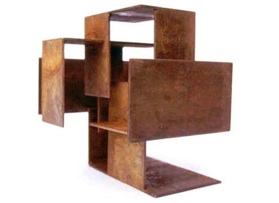
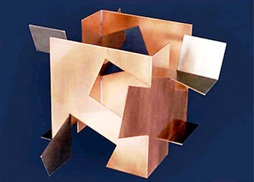
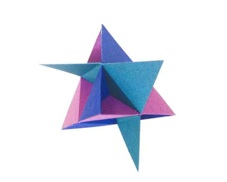
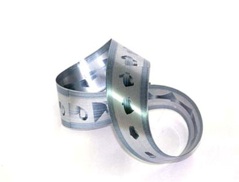
Figures XX. Student’s exercises on the language of the plane (physical models)
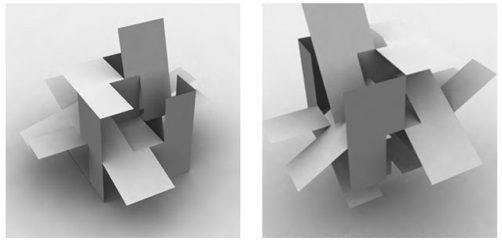
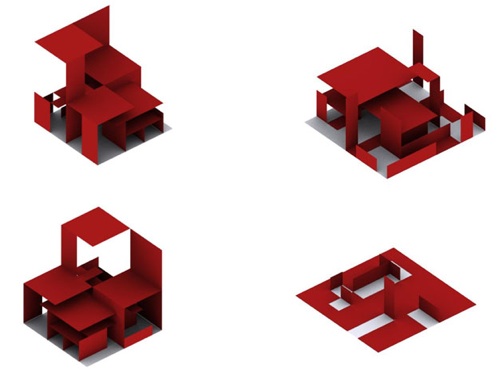
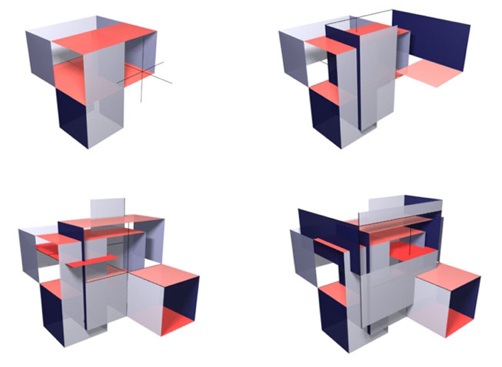
Figures XX. Student’s exercises on the language of the plane (animation frames)
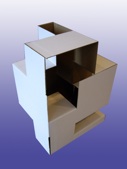
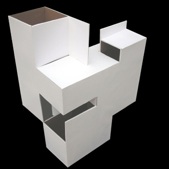
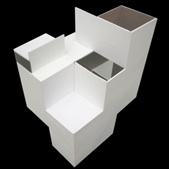
Figures XX. Student’s exercises on the language of the plane (cardboard boxes)
Object: Solid
The early works from Vantongerloo are an example of the exploration of the language of the solid in the plastic arts: abstract compositions of interpenetrating masses, of solids carved by voids. Malevich’s Architektons, their symbolism notwithstanding, are aggregations of solids, constellations of elements attracting each other. With his spatial constructions, Rodchenko systematically explores de (the) combinations of a limited number of blocks to create simple objects which –attending to the balance between mass and space– can be characterized as solids. In all these works, mass dominates over space; the void, if it exists, is to be found within the mass. In later works by Eduardo Chillida, space is not so much inside the mass, as it is surrounded by the mass (Chillida 2005). Intricate spaces, partially visible from the outside, are bounded by the mass. Unlike in the works of Oteiza, in Chillida the mass is necessary to make space visible. His is an architectural, rather than metaphysical, void.
We could argue, paraphrasing Giedion that thinking of architecture as a composition of masses is a fundamental ‘architectural conception’, particularly for modern architects –from Wright to Oud, from Loos to Le Corbusier– but also for earlier architects like Boullée and Ledoux. Also, an idea of architecture which is conceived as solids pervades more recent works of Erwin Heerich and Steven Holl. At this level of abstraction, when architecture is thought of as a composition of solids, the distinction between plastic arts and architecture blur.
Exercise: Solid
The exercise on the language of the solid is developed collaboratively from the start. The purpose of the exercise is to participate in a collaborative development process of a three-dimensional object carried out in successive stages (Figure XX). There is a vocabulary of transformation rules that is collectively created by the class before the beginning of the process. In this regard this exercise could be considered as an exercise in collaborative shape grammars.
The class is then divided into groups of 10-12 students. Each group starts with a seed object (e.g. a cube) and has two days to transform it, applying some of the rules previously defined. Along with the formal transformation, the student writes a brief explanation of what has happened to the object (e.g. which were the forces that gave rise to the transformation). This way, the written description facilitates the creation of a collaboratively generated narrative of the evolving object, which supports the role of metaphors in formal creation (at this point, the lectures on morphology are quite helpful). Once the first stage is completed, each group moves on to another process and chooses an object to be transformed. The same procedure is repeated two more times, although it could continue forever since there are no external criteria (functional, or any other type) which a ‘final object’ should comply with; only the internal requirements of the process set limits to its development.
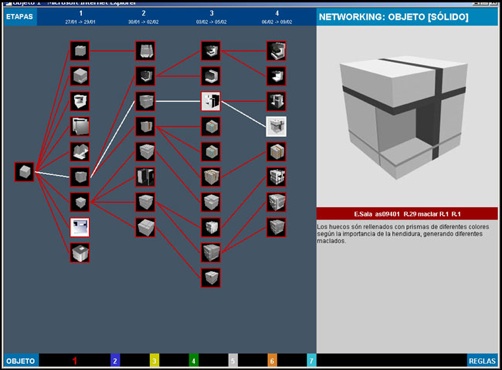
Figure XX. Interface to develop a solid object in collaboration.
With this exercise, the form of the process –rather than the form of the objects– becomes the purpose of the design. This is precisely what the web-based environment facilitates: the visualization of the process of development. In fact, the visualization of such a process, in which over one hundred students participate over a period of two weeks, it is only possible with the support of information technologies.
A second format for the exercise on the language of the solid focuses on the creation of objects with a limited set of blocks. In this case, we handed out 30 blocks, with three sizes and three colors (red, gray, white), in physical (rubber pieces) and digital formats (CAD model). In the composition of objects, students should pay attention to mass, proportion, relation between void and mass, color combination, among other issues. The work is carried out simultaneously on the computer and with the rubber pieces. By assembling the pieces on the computer, the rules of aggregation become explicit. The final results are presented with an animation showing the process of assembly, a series of renderings and the physical model.
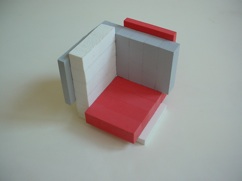

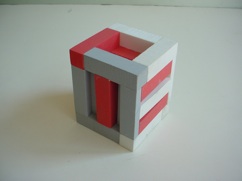
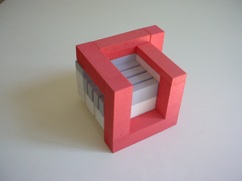
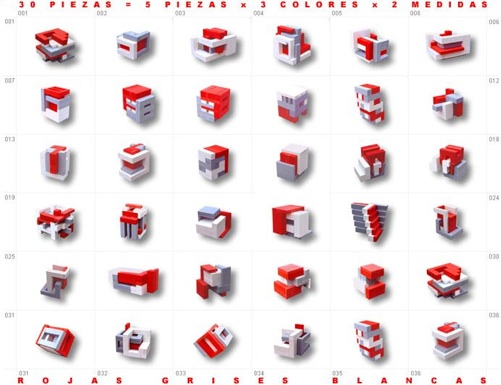

Figures XX. Student’s exercises on the language of the solid


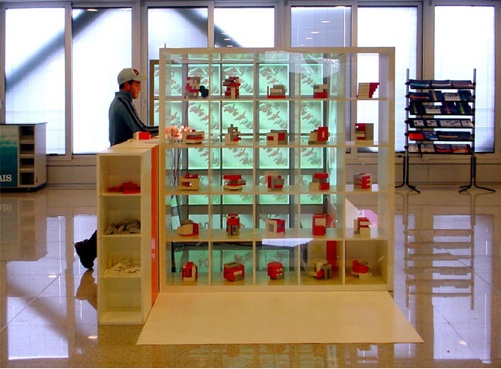
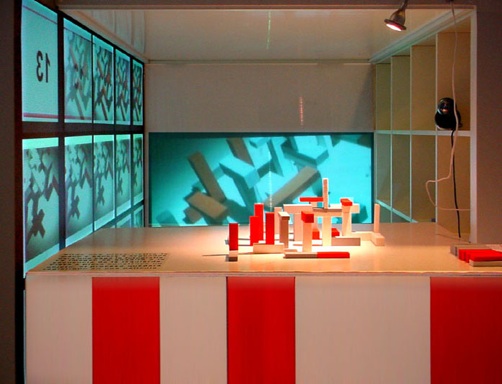
Figure XX. Installation for visitors to develop objects in collaboration
Conclusions
We believe that the pedagogy form, as it was established at the beginning of modern art, it is still a valid model of education, in so far as it has as objective to develop the student’s capacity to understand form, beyond disciplinary boundaries. This does not mean, however, that we have to apply uncritically the pedagogic methods of that time. Rather, it requires from us a capacity to develop further this pedagogic line making an intelligent use of the techniques available to our time, and continuously updating our knowledge of form in close contact with other disciplines.
References
Arnheim, R. Art and Visual Perception, University of California Press, Berkeley, 1974.
Brady, R. H. ‘Form and Cause in Goethe’s Morphology’, in F. Amrine, F. J. Zucker, H. Wheeler, Goethe and the Sciences: A Reappraisal, Reidel Publishing Company, Dordrecht, 1987, pp- 257-300.
Bermudez, J., King, K. ‘Media Interaction and Design Process: Establishing a Knowledge Base’. ACADIA Conference Proceedings, Québec City (Canada) October 22-25, 1998, pp. 6-25.
Brosterman, N. Inventing Kindergarten, Harry N. Abrams Inc., New York, 1997.
Brüderlin, M. Archisculpture, Hatje Cantz Publishers, 2005.
Cassirer, E. Problem of knowledge; philosophy, science, and history since Hegel, New Haven, Yale University Press, 1950.
Cassirer, E. Idee und Gestalt, Wissenschaftliche Buchgesellschaft, Darmstadt, 1971.
Chillida, E. Escritos, La Fábrica, Madrid, 2005.
Dollens, D. Digital to Analog Architecture, Lumen Books, Barcelona, 2003
Goethe, J. W. Schriften zur Morphologie; Dorothea Kuhn (editor), Bibliothek Deutscher Klassiker, Vol. 27, Frankfurt am Main, 1987.
Goethe, J. W. Italienische Reise, Verlag C.H. Beck, Munich, 2007.
Bayer, H., Gropius, W., Gropius, I. (editors) Bauhaus 1919-1928, Secker & Warburg, London, 1975.
Burchartz, M. Gestaltungslehre, Prestel Verlag, Munich, 1953.
Herbert, D. M. A ‘Critical Analysis of Design Process and Media: Applications for Computer-aided Design’, ACADIA Conference Proceedings, Washington University (Saint Louis / USA) 1994, pp. 133-146.
Hildebrand, A. Das Problem der Form in der bildenden Kunst, Heitz & Mündel, Strassbourg, 1910.
Judd, D. ‘Specific Objects’, in Donald Judd, Complete Writings 1959–1975, Halifax: The Press of the Nova Scotia College of Art and Design, 1975, pp. 181–189.
Kandinsky, Punkt und Linie zu Fläche, Benteli Verlag, Bern, 1955.
Khan-Magomedov, S. Vhutemas. Moscou 1920-1930, Editions du Regard, Paris, 1990.
Koffka, K. Principles of Gestalt Psychology. Harcourt, Brace and Company, New York, 1935.
Kohler, W. Gestalt Psychology, New York, 1929.
Lavrentiev, A. Alexander Rodchenko. The Iconography of Space. In Alexander Rodchenko. Spatial Constructions, Hatje Cantz, Ostfildern-Ruit, 2002.
Leborg, C. Visual Grammar, Princeton Architectural Press, New York, 2004.
Madrazo, L. ‘The Integration of Computer Modeling in Architectural Design’, Proceedings of ACADIA 90', Sky View, Montana, October 1990.
Madrazo, L. ‘Types and Instances: A Paradigm for Teaching Design with Computers’, Design Studies, Vol. 20, Number 2, March 1999.
Madrazo, L. ‘Computers and architectural design: going beyond the tool’, Automation in Construction, Volume 9, Number 1, January 2000, pp. 5-17.
Madrazo, L. ‘Systems of representation: a pedagogical model for design education in the information age’. Digital Creativity, Vol. 17, No. 2, 2006, pp. 73-90.
Malevich, K. The Non-Objective World. The Manifesto of Suprematism. Dover, New York, 2003.
Mitchell, W. J. The Logic of Architecture. Design, Computation, and Cognition. The MIT Press, Cambridge, 1990.
Novak, Marcos J. Computational Composition in Architecture, Computing in Design Education, ACADIA Conference Proceedings, Ann Arbor (Michigan / USA) 28-30 October 1988, pp. 5-30.
Oteiza, J. "Propósito Experimental 1956-1957", Catalogue Bienal Sao Paulo, 1957.
Reichardt, J. The Computer Art, Studio Vista, London, 1971.
Railing, P. ‘The Cognitive Line in Russian Avant-Garde Art’, Leonardo, Vol. 31, No. 1 (1998), pp. 67-73
Rodchenko, A. ‘The Line’. In Rodchenko-Stepanova. The Future Is Our Only Goal, catalogue of the exhibition, Munich, 1991, pp. 133-135.
Stiny, G. Shape. Talking about Seeing and Doing, Cambridge, The MIT Press, 2006.
Uttal, W. R. On Seeing Forms, Lawrence Erlbaum Associates, 1988
Troll, W. Gestalt und Urbild, Max Niemeyer Verlag, Halle, 1942.
Vöhringer, M. Avantgarde und Psychotechnik, Wallstein Verlag, Göttingen, 2007.
Wick, R. K. Teaching at the Bauhaus, Hatje Cantz, 2000.
Zellner, P. Hybrid Space, Thames & Hudson, London, 1999.
Notes
See http://www.salleurl.edu/sdr/description for a comprehensive description of the content, methods, tools of this course, as well as for a selection of students’ works.
See http://caad.arch.ethz.ch/teaching/nds/ws98/
Goethe, Schriften zur Morphologie, p.365.
Brady, ‘Form and cause in Goethe’s morphology’, pp. 257-258: “Morphology is, as the term suggests, an account of form –an ‘account’ that allows us a rational grasp of the perceived morphe by making its internal and external relations intelligible.
Goethe, Zur Morphologie, 1817: “Der Deutsche hat für den Komplex des Daseins eines wirklichen Wesens das Wort Gestalt. Er abstrahiert bei diesem Ausdruck von dem Beweglichen, er nimmt an, daß ein Zusammengehöriges festgestellt, abgeschlossen und in seinem Charakter fixiert sei.”
See Ernst Cassirer, ‘The Idea of Metamorphosis and Idealistic Morphology’, in E. Cassirer, The Problem of Knowledge: Philosophy, Science, and History since Hegel, p.137.
Goethe, Italienische Reise, p. 324: “Die Urpflanze wird das wunderlischste Geschöpf von der Welt, um welches mich die Natur selbst beneiden soll. Mit diesem Modell un dem Schlüssel dazu kann man alsdann noch Pflanzen ins Unendliche erfinden, die konsequent sein müssen, das heisst, die, wenn sie auch nicht existieren, doch existiern könnten und nicht etwa malerische oder dichterische Schatten und Scheine sind, sondern eine innerlich Wahrheit und Notwendigkeit haben.”
For Goethe, mathematics had not role to play in morphology. Later, however, D’Arcy Thompson, in On Growth and Form, turned to geometry and mathematics to explain the causes given rise to forms in nature. ‘’
Troll, Gestalt und Urbild, p. 35: “Goethes Verfahren ist synthetisch. Wenn man in der exakten Wissenschaft von einer exakten Analyse spricht, so setzt dieser Goethe das Verfahren der ‘exakten sinnlichen Phantasie’ entgegen, die aus einer Vielheit der Phänomene das in allen enthaltene „Bildungsgesetz“ abstrahiert; die Vielheit zeight seinem ‘geistigen Auge’ ‘innerlich eien virtuelle Gleichheit’, den Typus, die reine Gestalt oder auch die Idee.”
Köhler, Gestalt Psychology, p. XXX.
As Rawlins had contended, there is an intrinsic difficulty to render the concept of Gestalt in the English language, which still pervades in the discussion of the meaning of the term: “It is almost impossible to render Gestalt satisfactorily into English: it means ‘configuration’, ‘shape’, ‘whole’, or ‘form’, with an underlying insistence upon an integrative property, and by such an integrative property is suggested that the Gestalt is meaningless, apart from the inclusion of the ‘parts’ within the ‘whole’. Yet these ‘parts’ bear to the ‘whole’ (the Gestalt) a very peculiar relationship. Their co-operation is essential, and yet the end-result differs from them not only in degree but in kind.” Ian Rawlins, Aesthetics and the Gestalt, pp. 23-24
According to Uttal, a Gestalt is “a function of both the perceiving organism and the stimulus”. See Uttal, On seeing forms, p. XX.
There is a clear affinity between Kandinsky’s design theory and Goethe’s morphology: “Die Verwendung der Linie in der Natur ist eine überaus zahlreiche. Dieses einer speziellen Untersuchung würdige Thema könnte nur ein synthetischer Naturfoscher bewältigen. Für den Künstler wäre es besonders wichtig, zu sehen, wie das selbständige Reich der Natur die Grundelemente verwendet: welche Elemente in Betracht kommen, welche Eigenschaften sie besitzen und auf welche art sie sich zu Gebilden zusammensetzen.” Kandinsky, Punkt und Linie zur Fläche, pp. 115-116.
Ibid., p. 100.
Adolf von Hildebrand, Das Problem der Form in der Bildenden Kunst, p. VIII: “Architektur fasse ich dann nur als Bau eines Formganzen, unabhängig von der Formensprache.”
Rudolf Arnheim, Art and Visual Perception, p. 4: “The word gestalt, the common German noun for shape or form, has been applied since the beginning of our century to a body of scientific principles that were derived mainly from experiments in sensory perception. It is generally admitted that the foundations of our present knowledge of visual perception were laid in the laboratories of he gestalt psychologists, and my own development has been shaped by the theoretical and practical work of this school.”
References to a structure underlying the visible shapes can still be found in recent design manuals. In Christian Leborg’s Visual Grammar, however, one single term -structure- encompasses both the visible and the invisible, as he refers to structures which can be abstract and concrete, active and inactive, visible and invisible.
In his autobiography, Froebel had written: “I could already perceive unity in diversity, the correlation of forces, the interconnection of all living things, life in matter, and the principles of physics and biology”. Quoted in Brosterman, Inventing Kindergarten, p.18.
See Wick, Teaching at the Bauhaus, pp. 174-175.
Ibid. p. 114: “It is obvious that his pedagogy was not nourished on the spirit of the academic training for artists or on the sources of orthodox drawing but rather stood in the tradition of the liberal pedagogical reform movement of Rousseau, Pestalozzi, Fröbel, Montessori, and others.”
S. Khan-Magomedov, Vhutemas. Moscou 1920-1930, vol. 1, p. 281: “Les étudiants doivent résoudre des problèmes de composition en tenant compte de certains impératifs: exprimer un volume dans l’espace, montrer l’interpénétration des masses, ou encore utiliser un ensemble donné de formes et d’objets, sphère, cube parallélépipède, cylindre, cône, pyramide,..”
Margaret Vöhringer, Avantgarde und Psychotechnik, pp.37-38.
Max Burchartz, Gestaltungslehre, p. 30: “Die Unterweisung in der Kenntnis der Grundlagen und Grundgesetze allen Gestaltens und in der Wertbeurteilung eines Geformten nennt man Gestaltungslhere”.
Other terms have been used for the same purpose: the constructivists for example, use the name construction to name those objects which did not adhere to any of the traditional art forms. Also the term ‘proun’ coined by Lissitzky, was meant to stand for objects which could not be described as painting, sculpture or architecture. More recently, Donald Judd has used the term “specific objects” to refer to three-dimensional objects which were neither paintings nor sculptures (Judd 1975).
In Genetic Architectures, Denis Dollens speaks of a “digital-botanic architecture fusing electronic visualization with technology, the environment, biomimetics, and rapid prototyping” (Dollens 2003, p. 71). As a matter of fact, the aesthetic significance of such genetic architecture is not self-evident.
This is the idea of language adopted by shape grammars, according to George Stiny: “My idea was that a grammar had a limited number of rules that could generate an unlimited number of different things, and that the resulting language was the set of things the rules produced.” (Stiny 2006, p. 18)
In this regard, the notion of formal language we are considering comes closer to the idea of a grammar stemming from a vocabulary of elements, always evolving and changing, as expressed by Kandinksy in Punkt und Linie zu Fläche (Kandinsky 1955, p. 90).
Moving from an abstract, sculptural object into an architectural object is not necessarily a continuous transition. In this regard, see Archisculpture, catalogue of the exhibition of the same name (Brüderlin 2005).
A tool developed by Kai Strehlke in 1998, presented as Master thesis with the title ‘Entwicklung und Verknüpfung einer 3D-Modellierumgebung im Internet mit einer MYSQL Datenbank in the postgraduate studies directed by the author at the ETH Zurich during 1996-1999, was based on a similar generative principle: by moving a cubic cell along each one of the axis in three-dimensional space it was possible to construct linear structures without having to use modelling techniques.